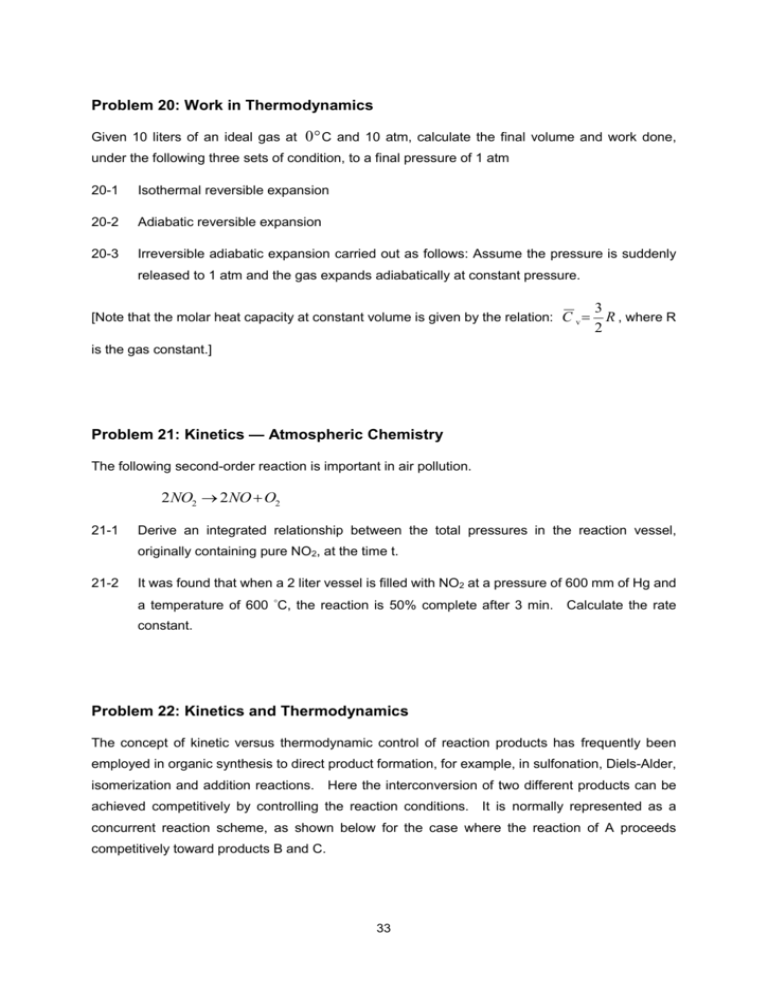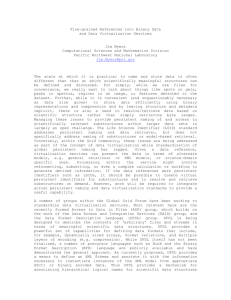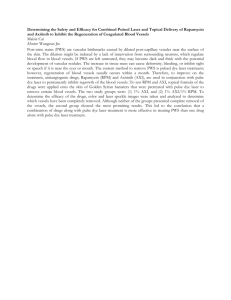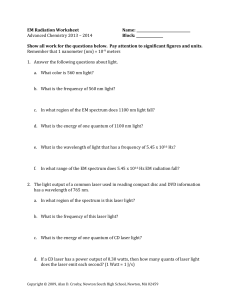Problem 20: Work in Thermodynamics
advertisement

Problem 20: Work in Thermodynamics Given 10 liters of an ideal gas at 0 C and 10 atm, calculate the final volume and work done, under the following three sets of condition, to a final pressure of 1 atm 20-1 Isothermal reversible expansion 20-2 Adiabatic reversible expansion 20-3 Irreversible adiabatic expansion carried out as follows: Assume the pressure is suddenly released to 1 atm and the gas expands adiabatically at constant pressure. [Note that the molar heat capacity at constant volume is given by the relation: C v 3 R , where R 2 is the gas constant.] Problem 21: Kinetics — Atmospheric Chemistry The following second-order reaction is important in air pollution. 2 NO2 2 NO O2 21-1 Derive an integrated relationship between the total pressures in the reaction vessel, originally containing pure NO2, at the time t. 21-2 It was found that when a 2 liter vessel is filled with NO2 at a pressure of 600 mm of Hg and a temperature of 600 C, the reaction is 50% complete after 3 min. Calculate the rate constant. Problem 22: Kinetics and Thermodynamics The concept of kinetic versus thermodynamic control of reaction products has frequently been employed in organic synthesis to direct product formation, for example, in sulfonation, Diels-Alder, isomerization and addition reactions. Here the interconversion of two different products can be achieved competitively by controlling the reaction conditions. It is normally represented as a concurrent reaction scheme, as shown below for the case where the reaction of A proceeds competitively toward products B and C. 33 k1 k2 B A C, k 1 k2 The energy profile for the reaction is depicted in the Figure below. 22-1 Given the rate constants k1=1, k-1=0.01, k2=0.1, and k-2=0.0005 min-1, estimate the product ratio B/C in the first 4 min of the reaction. 22-2 Using the same rate constants, estimate the product ratio B/C when the reaction time exceeds 4 days. 22-3 B is called the kinetic-controlled product, while C is called the thermodynamic-controlled product. When the temperature of the system increases, which reaction process is favored? Problem 23: Phase Diagram The phase diagram is a convenient way to indicate the phases of a substance as a function of temperature and pressure. Answer the following questions based on the phase diagram of water given below: 23-1 What phases are present at A, B, and C? 23-2 Why does ice not sink in its own liquid? 34 23-3 When water freezes, it expands. Explain this observation using the Clapeyron equation, which may be expressed by dp H . Here, ΔH and ΔV denote the change of molar dT TV enthalpy and molar volume of water, respectively. 23-4 A glass container partially filled with water is connected to a vacuum pump. What changes will be observed when the pump is turned on? 23-5 A man is skating on the surface of a sheet of ice where the air pressure is 1 atm and the o temperature is 0 C. What changes will be observed along the skating track on the surface of the ice, assuming the ice can withstand his weight without cracking? Problem 24: Standard Deviation in One - Dimensional Quantum Mechanics Some measurable physical quantity, if measured numerically, may lead to an uncertainty which is expressed by a standard deviation, . Such a standard deviation is defined as = G 2 G 2 , where G is a measurable physical property; <G> is the average value of G; <G2> is the average value of G2. The average values, <G> and <G2>, can be obtained by integrating the corresponding physical quantity multiplied by its probability distribution over all the values of G. This definition may be applied to both classical and quantum mechanical worlds. Two examples related to the estimate of , one for the kinetic property of gaseous molecules and the other for the 35 particle motion in one dimension, are given in the following. 24-1 The distribution of speeds of gaseous molecules at a fixed temperature can be described by the following probability density, called the Maxwell-Boltzmann distribution, M F ( v) 4v 2RT 2 3/ 2 Mv 2 exp 2 RT where v is the speed of molecule, M is the mass of molecule, T is the temperature in Kelvin, and R is the gas constant. Calculate the average speed, <v>, and the standard deviation, v, of the distribution of speeds of the O2 molecules at 300 K. (O2 = 32 g/mol, R = 8.31 J -1 -1 K mol ) 24-2 Suppose a particle moving in the x direction has a normalized wavefunction, [(1 / 2 ) exp( x 2 / 2)]1 / 2 ; x , Calculate the average position, <x>, and the standard deviation, x , of the position distribution of the particle after a large number of measurements of x. 24-3 In quantum mechanics, momentum for one dimension can be expressed by an operator, i.e., p= ih d , where h is the Planck’s constant. Calculate the average momentum, 2 dx <p>, and the standard deviation, p, for the particle with the same wavefunction described in part 2. 24-4 Calculate the uncertainty product of position and momentum, xp, for the above quantum mechanical example. Some useful integrals are given below: 0 0 1 3 5 (2n 1) x exp( ax )dx 2 n 1 2 n 1 a 2n 1/ 2 2 x 2 n 1 exp( ax 2 )dx n! 2a n 1 where n = 0,1,2,3… Problem 25: A Particle in a 2-D Box Quantum Mechanics The electrons of the iron-heme of a hemoglobin molecule can be visualized as a system of free electrons moving in a two-dimensional box. According to this model, the energy of the electron is 36 limited to the values where h=6.63 x 10 me=9.11 x10 -31 -34 J s is the Planck constant; nx and ny are the principal quantum numbers; kg is the electron mass; L is the length of the box. 25-1 Construct an energy level diagram showing the relative ordering of the lowest 17 orbitals. 25-2 Given the molecule contains 26 electrons, determine the electron population of the highest occupied orbitals in the ground state. 25-3 Assuming Hund's rule can be applied to this system, predict whether or not this system is paramagnetic. 25-4 Light is absorbed only when the condition h = E is satisfied. If the length L for this 2D box is 1 nm, what is the longest wavelength of light that can lead to excitation? Express 8 your result in nm. [The speed of light, c = 3.00 x10 m/s] Problem 26: Spectral Analyzer The configuration of the distributed feedback dye laser (DFDL) system is shown in Fig. 1, and consists of an oscillator and a preamplifier. Beam splitter Laser (355 nm) < Cylindrical lens Dye cell-2 DFDL Slit Dye cell-1 < Wavemeter preamplifier Mirror Mirror Grating oscillator Fig. 1. Block diagram of the distributed-feedback dye laser. 37 The oscillator is made of a quartz cuvette (dye cell-1) equipped with a dye circulation pump. The detailed construction of the oscillator is shown in Fig. 2. Dye cell n Λ DFDL DFDL θ P P Fig. 2. The detailed construction of a DFDL oscillator Two laser beams (P = 355.00 nm) are reflected by two rotating dielectric mirrors and subsequently focused onto the dye solution to form an interference pattern, the spacing of which determines the wavelength of the laser emission. The wavelength of the laser emission, DFDL, can be calculated using the following equations: DFDL 2n p / 2 sin where n is the refractive index of the medium; , the fringe spacing; and θ, the angle from the normal surface. The laser wavelength can also be determined from the fringe spacing, which, in turn, can be determined from the angle of incidence of the pump beam. The DFDL beams come from two sides of the cell. The wavelength of the DFDL can be measured by a Wavemeter. The power of the DFDL can also be amplifier by passing it through a preamplifier (the second dye cell; dye cell-2). 26-1 What would be the wavelength of the DFDL when the angle of θ is 60.00 and the refractive index of the medium is 1.40? (a) 374 nm (b) 474 nm (c) 574 nm (d) 674 nm (e) 774 nm 38 Problem 27: Time-of-Flight Mass Spectrometer There are numerous ways in which we may separate and select ions in a mass spectrometer. Magnetic and electric fields, as well as radio frequency are often used to separate ions in mass spectrometers. The time-of-flight (TOF) mass spectrometer is the simplest type of common mass analyser and it has a very high sensitivity. With the introduction of matrix-assisted laser desorption / ionization (MALDI) or electrospray ionization (ESI), which is used to introduce and ionize macromolecules such as proteins, DNA, and polymers, the measurement of a large mass range became achievable. It is now possible to desorb and analyze ions with molecular weights upwards of one million atomic mass units (amu; 1 amu = 1.6605 × 10 -27 kg). In general, the sample ions are generated in a source zone of the instrument, by whatever ionization method is being employed. A high voltage (HV) potential is applied across the source to extract and accelerate the ions from the source into the field-free “drift” zone of the instrument. The fundamental operating principle of TOF is that ions of the same kinetic energy will move with different velocities depending on their m / z value. This can be seen in the following equation, the classical equation for kinetic energy. KE = ½ m 2 This relationship may be rearranged to give velocity in terms of kinetic energy and m / z. = (2 • KE/m)½ If the distance from the point of ion formation to the detector at some fixed point is L (neglecting the extraction time from the source), the time of flight (t) can be calculated by the following equation: t = L / = L / (2 • KE/m)½ In most modern TOF mass spectrometer, ions are generally accelerated to kilo-electron volt (keV) energies. At these energies, flight times will be in the range of a few tens to a few hundreds of microseconds (s) (depending on the flight distance). The kinetic energy of an ion accelerated by a potential is given by: KE = zeV Where z is the number of charges on the ion, e is the fundamental unit of charge (1.6022 × 10 -19 C) and V is the applied accelerating potential in volts. 27-1 An average protonated cytochrome has a molecular weight of 12,361 amu. What will be + the velocity of the (MH ) ion of the cytochrome when accelerated by a potential of 20,000 volts? (a) 18000 m/s 39 (b) 28000 m/s (c) 38000 m/s (d) 48000 m/s (e) 58000 m/s 27-2 If the detector is positioned 1.00 m from the point of ion formation, the time of flight for the ion will be approximately: (a) 40 s (b) 50 s (c) 60 s (d) 70 s (e) 80 s 40








